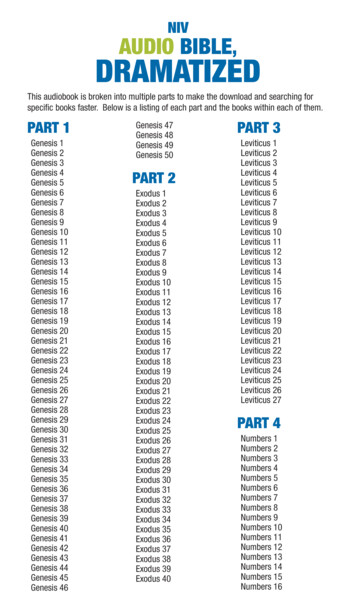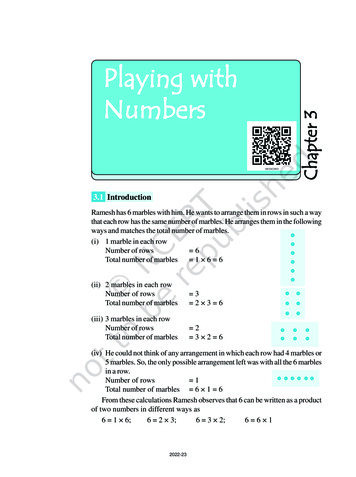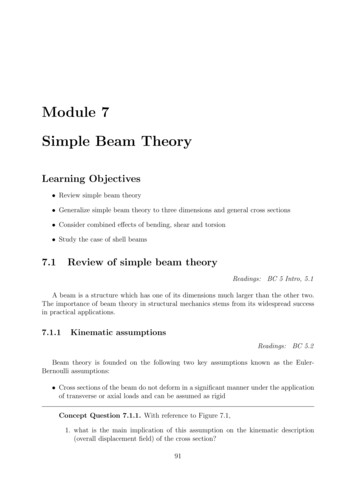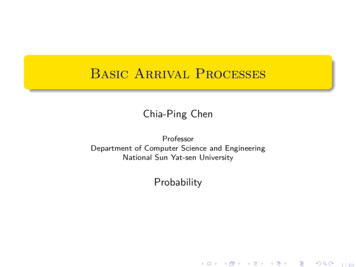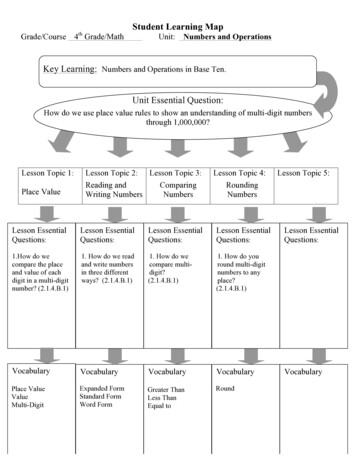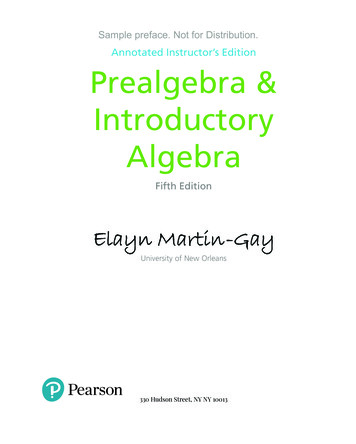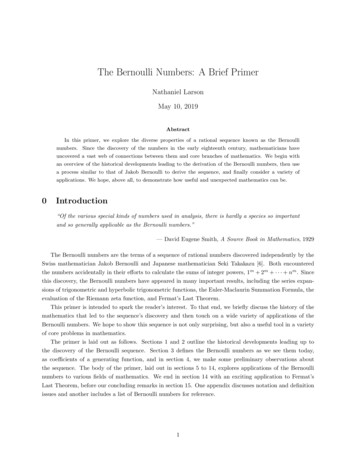
Transcription
The Bernoulli Numbers: A Brief PrimerNathaniel LarsonMay 10, 2019AbstractIn this primer, we explore the diverse properties of a rational sequence known as the Bernoullinumbers. Since the discovery of the numbers in the early eighteenth century, mathematicians haveuncovered a vast web of connections between them and core branches of mathematics. We begin withan overview of the historical developments leading to the derivation of the Bernoulli numbers, then usea process similar to that of Jakob Bernoulli to derive the sequence, and finally consider a variety ofapplications. We hope, above all, to demonstrate how useful and unexpected mathematics can be.0Introduction“Of the various special kinds of numbers used in analysis, there is hardly a species so importantand so generally applicable as the Bernoulli numbers.”— David Eugene Smith, A Source Book in Mathematics, 1929The Bernoulli numbers are the terms of a sequence of rational numbers discovered independently by theSwiss mathematician Jakob Bernoulli and Japanese mathematician Seki Takakazu [6]. Both encounteredthe numbers accidentally in their efforts to calculate the sums of integer powers, 1m 2m · · · nm . Sincethis discovery, the Bernoulli numbers have appeared in many important results, including the series expansions of trigonometric and hyperbolic trigonometric functions, the Euler-Maclaurin Summation Formula, theevaluation of the Riemann zeta function, and Fermat’s Last Theorem.This primer is intended to spark the reader’s interest. To that end, we briefly discuss the history of themathematics that led to the sequence’s discovery and then touch on a wide variety of applications of theBernoulli numbers. We hope to show this sequence is not only surprising, but also a useful tool in a varietyof core problems in mathematics.The primer is laid out as follows. Sections 1 and 2 outline the historical developments leading up tothe discovery of the Bernoulli sequence. Section 3 defines the Bernoulli numbers as we see them today,as coefficients of a generating function, and in section 4, we make some preliminary observations aboutthe sequence. The body of the primer, laid out in sections 5 to 14, explores applications of the Bernoullinumbers to various fields of mathematics. We end in section 14 with an exciting application to Fermat’sLast Theorem, before our concluding remarks in section 15. One appendix discusses notation and definitionissues and another includes a list of Bernoulli numbers for reference.1
TABLE OF CONTENTS2Table of Contents1 Uncovering the Bernoulli Numbers: A History32 Following in Bernoulli’s Footsteps: Sums of Powers53 The Bernoulli Generating Function74 Preliminary Observations94.1The Bernoulli Numbers Are Rational . . . . . . . . . . . . . . . . . . . . . . . . . . . . . . . .104.2The Odd Bernoulli Numbers (Except B1 ) Are Zero . . . . . . . . . . . . . . . . . . . . . . . .115 Bernoulli Numbers and Cotangent136 The Riemann Zeta Function137 Bernoulli Polynomials208 The Euler-Maclaurin Summation Formula259 Applications of Euler-Maclaurin Summation289.1Revisiting the Sums of Powers . . . . . . . . . . . . . . . . . . . . . . . . . . . . . . . . . . . .289.2Euler’s Constant . . . . . . . . . . . . . . . . . . . . . . . . . . . . . . . . . . . . . . . . . . .299.3Stirling’s Formula . . . . . . . . . . . . . . . . . . . . . . . . . . . . . . . . . . . . . . . . . . .3010 The Bernoulli Numbers Grow Large3111 The Clausen-von Staudt Theorem3412 Direct Formulas3613 Bernoulli Numbers in Matrices3813.1 Pascal’s Matrix . . . . . . . . . . . . . . . . . . . . . . . . . . . . . . . . . . . . . . . . . . . .3813.2 Bernoulli Numbers with Determinants . . . . . . . . . . . . . . . . . . . . . . . . . . . . . . .4013.3 The Bernoulli Matrix . . . . . . . . . . . . . . . . . . . . . . . . . . . . . . . . . . . . . . . . .4114 The Regular Primes4115 Conclusion4316 Acknowledgements4317 Appendix: Notation and Definitions4517.1 The Sums of Powers . . . . . . . . . . . . . . . . . . . . . . . . . . . . . . . . . . . . . . . . .4517.2 The First and Only Odd Bernoulli Number: B1 . . . . . . . . . . . . . . . . . . . . . . . . . .4517.3 The Euler-Maclaurin Summation Formula . . . . . . . . . . . . . . . . . . . . . . . . . . . . .4617.4 The Bernoulli Matrix . . . . . . . . . . . . . . . . . . . . . . . . . . . . . . . . . . . . . . . . .4718 Appendix: List of Bernoulli Numbers47
11UNCOVERING THE BERNOULLI NUMBERS: A HISTORY3Uncovering the Bernoulli Numbers: A HistoryThe Bernoulli numbers were discovered in the process of solving an ancient problem. Both Jakob Bernoulliand Seki Takakazu stumbled across the sequence while trying to find a general formula for the “sums ofinteger powers,” defined asSm (n) 1m 2m 3m · · · nmfor positive integers n and m. In this section, we examine the the work of other prior mathematicians onthe problem. The story is both fascinating and useful to us, because it (1) demonstrates how elusive thesequence was, even to some of the great mathematical minds of each era, (2) how mathematics has been (not)communicated throughout history, and (3) how we, as mathematicians and historians, choose to memorializesome important figures and not others.Since antiquity, mathematicians struggled to sum the integer powers [1]. In some cases, the mathematicians were driven by curiosity. Others needed formulas to solve specific problems in engineering and physics.Many mathematical minds made progress on the problem, but a general formula proved elusive.Archimedes of Syracuse (287-212 BC), the greatest mathematician of antiquity and perhaps of all time[6], is one of the first people on record to have considered solving for the sums of integer powers. In thefashion of many great mathematicians, he may have discovered a formula for the sums of squares, but didn’tformally state it. Rather, he simply used it as a step in another proof.Aryabhata (b. 476), a major early physicist and astronomer in India, discovered a formula for the sumsof cubes. Abu Bakr Al-Karaji of Baghdad (d. 1019), an engineer and mathematician, wrote out the sums ofcubes up to 10. It is likely that he derived a formula as well. In the next decade, the Iraqi mathematicianAbu Ali al-Hassan ibn al Haytham (965-1039)–known as “Alhazen” in Europe–wrote his magnum opus, the1seven-volume Optics, which included a result that required knowledge that S4 (n) 51 n5 12 n4 13 n3 30n.This knowledge was not passed on, because he did not specifically state the result.European mathematicians rediscovered methods to calculate the sums of fourth powers much later–inthe sixteenth and seventeenth centuries–but took the results significantly further. Thomas Harriot (15601621), a mathematician and scientist under the patronage of Sir Walter Raleigh, used “difference tables” tocalculate the sums of fourth powers on a voyage to the colony of Virginia in 1585. He also introduced newsymbolic notation, a development that put him well ahead of many of his contemporaries, who still wrote outall of their mathematical calculations in sentences. Unfortunately, Harriot never published the 5000 pagesof mathematical notes he wrote and only passed on some of his knowledge through letters.Pierre de Fermat (1601-1665), a French lawyer, discovered his own formula for the sums of fourth powers,which he used to compute definite integrals of the form cxk . Like Harriot, he never published his work, butinstead corresponded regularly with several other amateur and professional mathematicians. Historians believe that his technique of using power series to determine area inspired Newton as he developed a frameworkfor calculus in the period from 1665 to 1670.Blaise Pascal (1623-1662) built upon the advances of his predecessors. He introduced his now-famousArithmetical Triangle to the problem to use previous sums of powers to calculate the next. This system theoretically allowed the computation of every sum of powers, but in practice it quickly became too convolutedto accurately use.What both Fermat and Pascal missed, say historical scholars, was the work of Johann Faulhaber (15801635). Born into a family of basket-weavers in Ulm, Germany, Faulhaber displayed a great talent forcomputation. He started a mathematics school in his hometown, which became well-known to a number
1UNCOVERING THE BERNOULLI NUMBERS: A HISTORY4of mathematicians (although clearly not all), including René Decartes, who sought him out as a tutor. In1610, Faulhaber made significant strides on the problem of the sums of integer powers by calculating explicitformulas for sums up to the tenth power. In Academia Algebrae, his 1631 masterwork, he gave formulas forpowers up to twenty-three.Faulhaber, as a matter of historical interest, was also quite eccentric. He believed in what he called“figured numbers” from the Bible, and used them to try to predict future events. In fact, he was jailedfor predicting the end of the world in 1605. He claimed later he also could convert lead into gold. Despitethese eccentricities, or perhaps because of them, the serious mathematical work of Faulhaber was relativelyunknown during his time, and remains so today. Only one surviving copy of Academia Algebrae is known toexist today.Despite the lineage of European mathematicians who worked on the sums of powers for centuries, itwas actually a Japanese mathematician, Seki Takakazu (1642-1708), who first discovered the “Bernoullinumbers.” Seki was born in Fujioka Gumma, Japan to a samurai warrior family. From an early age, Sekidemonstrated prodigious mathematical talent, and in his later years he is credited with transforming thestudy of mathematics in Japan. In 1683, Seki became the first mathematician to study determinants (beforeLeibniz), and used them to solve more general equations than Leibniz did ten years later. Seki had amethod analogous to Newton polynomial interpolation and solved cubic polynomials using a method not yetdiscovered in Europe. Furthermore, using a technique called Ruisai Shosa-ho, he discovered the sequence ofthe Bernoulli numbers and their role in computing the sums of powers.Halfway around the world, Jakob Bernoulli (1655-1705) was born in Basel, Switzerland to a family ofmerchants. If the name Bernoulli sounds familiar, it should. Within two generations in the seventeenthcentury, the Bernoulli family produced a dozen prominent mathematicians and scientists. For example, thefamous “Bernoulli Principle” in physics, which describes how fast-moving air over a surface generates lift,was named for Jakob Bernoulli’s nephew, Daniel, the son of Jakob’s brother (and rival) Johann. JakobBernoulli discovered the number e 2.718 . . . , developed the beginnings of a theory of series and proved thelaw of large numbers in probability theory, but contributed most significantly to mathematics with his workArs Conjectandi. In this work, he laid out his solutions to the first ten sums of powers, and the sequence ofnumbers he uncovered during his calculations.These two mathematicians were situated in very different cultural and mathematical worlds, but managedto uncover this important sequence of numbers at nearly the same time. We appreciate contemporarymathematicians who refer to the numbers as the Seki-Bernoulli numbers, because it follows the conventionto give both discoverers credit in the case of independent discovery (e.g. the Euler-Maclaurin SummationFormula, the Calusen-von Staudt Theorem). In this primer, we choose to call the sequence the “Bernoullinumbers” to increase readability (although this may change). We also acknowledge that the body of workdeveloped using the Bernoulli numbers was inspired largely by the work of Bernoulli rather than Seki.However, this comes after significant consideration, and I do not believe this is the best or only conclusionto reach.I find it important to note the history of mathematics is not equitable. History is not what happened,but merely what has been recorded, and most of what has been recorded in English has a distinctly Westernbent. This is particularly true in the field of mathematical history. Records emphasize Greek, German,English, French, Russian, Italian, and other European contributions while neglecting major work from otherparts of the world. As Leigh Wood states in Mathematics Across Cultures: The History of Non-WesternMathematics, “mathematics itself is not one culture with one discourse” [19]. That is why I find it important,
2FOLLOWING IN BERNOULLI’S FOOTSTEPS: SUMS OF POWERS5for example, to recognize the work of early Indian, Egyptian, and Iraqi mathematicians to the problem ofthe sums of powers. The West has dominated mathematical thought for the past few centuries, but beforethat, it was Asian, Middle Eastern, and even pre-Colombian American cultures that drove mathematicaldiscovery for millennia. Even during the height of European mathematics, significant contributions weremade by non-Europeans who have not been properly recognized. Such is the case of Seki Takakazu.After Seki Takakazu and Bernoulli independently discovered the sequence of numbers in the early eighteenth century, mathematicians began to find connections between the sequence and many mathematicalfields. Among the contributors to this body of research are a number of familiar names in (European) mathematical history, among them: Abraham de Moivre (1667-1754), Colin Maclaurin (1698-1745), Karl GeorgChristian von Staudt (1798-1867), Ernst Edward Kummer (1810-1893), Adrien-Marie Legendre (1752-1833),Peter Dirichlet (1805-1859), and Georgii Voronoi (1868-1908). In this primer, we will dedicate significanttime to the results of Léonard Euler (1707-1783), who was one of the first to study the sequence in depth afterBernoulli’s publication. I will note that no work building off of Seki’s discovery was found in my research.Perhaps his discovery was not shared widely, or the appropriate historical records are simply not accessiblein English.2Following in Bernoulli’s Footsteps: Sums of PowersSeki Takakazu’s method for finding the Bernoulli numbers is not easily converted to Western notation, solet us derive the sequence by Jakob Bernoulli’s method. Bernoulli’s process was not unlike those of someof his predecessors, but he made several keen observations that led to a final solution. In this section, weapproximately retrace his steps.In Ars Conjectandi, Bernoulli calculated the formulas for Sm (n) up to ten using the methods of Fermat[1]. Here, we have listed the first six sums up to the integer n 1, because this form allows us more clearlyto see useful patterns:S1 (n 1) S2 (n 1) S3 (n 1) S4 (n 1) S5 (n 1) S6 (n 1) 1 2n21 3n31 4n41 5n51 6n61 7n71 n21 2 n21 3 n21 4 n21 5 n21 6 n21 n61 n241 n335 n4121 n521n301 n2121 n36 We can observe, as he did, that the leading term of the formula for each Sm (n 1) is 1n421m 1.m 1 nBernoulli
2FOLLOWING IN BERNOULLI’S FOOTSTEPS: SUMS OF POWERSfactored out the fractionS1 (n 1) S2 (n 1) S3 (n 1) S4 (n 1) S5 (n 1) S6 (n 1) 1m 1 1 2n2 1 3n3 1 4n4 1 5n5 1 6n6 1 7n76from each polynomial and obtained the following chart: n3 n22 2n35 n42 3n57 n62 1 n2 2 n5 n335 n427 n52 1 n6 1 2 n27 n361 n6 The next observation he made was more subtle. Consider the second column of terms. Each is a multipleof 21 : 1 2 · 12 , 32 3 · 21 , 2 4 · 12 , and so on. The third column contains multiples of 16 , and the1. If we factor these terms out of each formula, get obtain,fourth, multiples of 30S1 (n 1) S2 (n 1) S3 (n 1) S4 (n 1) S5 (n 1) S6 (n 1) 1 2n2 1 3n3 1 4n4 1 5n5 1 6n6 1 7n7 1 2n2 1 2 3n2 1 3 4n2 1 4 5n2 1 5 6n2 1 6 7n2 1 36 1 66 1 3 10n6 1 4 15n6 1 5 21n6 1 5n30 1 15n230 1 35n330 1 7n42Our next step arises unexpectedly. If we look at the integer coefficients that remain for each term, we maynotice what Bernoulli did: that the integers are all binomial coefficients corresponding to the row of m. Itlooks almost like Pascal’s Triangle, with a few gaps that we can replace by terms multiplied by zero. If we
3THE BERNOULLI GENERATING FUNCTION7write the formulas out in this way, we get 1 2 2n2 0 1 3 3S2 (n 1) n3 0 1 4 4S3 (n 1) n4 0 1 5 5S4 (n 1) n5 0 1 6 6S5 (n 1) n6 0 1 7 7S6 (n 1) n7 0S1 (n 1) 2 1n1 2 3 1 2 n1 2 4 1 3 n1 2 5 1 4 n1 2 6 1 5 n1 2 7 1 6n 1 2 3 1n2 6 4 1 2 n2 6 5 1 3 n2 6 6 1 4 n2 6 7 1 5n 2 6 40n3 5 0n23 6 0n33 7 0n43 5 1n4 30 6 1 2 n4 30 7 1 3n 4 30 60n5 7 0n25 7 1n6 42At this point, we suddenly see a pattern that connects all of the formulas. In fact, we can write out acompact equation, one that we prove in section 9:Sm (n 1) m 1 X m 1Bk nm k 1m 1k(1)k 0where Bk is the mysterious sequence of numbers that we factored out in the second step,1111B0 1, B1 , B2 , B3 0, B4 , B5 0, B6 , B7 0, . . .263042These are the Bernoulli numbers.Bernoulli realized that this sequence was valuable to the problem he solved, but did not do further workwith the numbers. After Bernoulli’s publication, the next mathematician to work with the sequence in depthwas Leonard Euler (1707-1783). He used the Bernoulli numbers to derive a solution to the even values of thezeta function and develop a general summation formula (the Euler-Maclaurin Summation Formula) in the1730s. However, he did not introduce his now-standard definition for the sequence until two decades later,perhaps due to the “lack of any obvious pattern among the Bernoulli numbers” [6]. Even to Euler, thesenumbers were mysterious and difficult to pin down.3The Bernoulli Generating FunctionIn 1755, Euler posed the following definition for the Bernoulli numbers, which remains the most commonmodern definition for the sequence.Definition 3.1. The Bernoulli numbers are the coefficients of the exponential generating function X Bk xkx .ex 1k!k 0Euler’s formal definition for the Bernoulli numbers is based on the concept of a generating function,which is a method of encoding a sequence. To review: we say that f is an “ordinary” generating function
3THE BERNOULLI GENERATING FUNCTION8for the sequence {an } n 0 iff (x) a0 a1 x a2 x2 · · · Xai xi .i 0Similarly, f is an “exponential” generating function for {bn } n 0 if X xix2x ··· bi .f (x) b0 b1 b21!2!i!i 0So, a function that is the ordinary generating function of {an } is the exponential generating function of{bn } n! · {an } {n! · an }. We use whichever function is more appropriate for a particular problem. Inthis case, the exponential generating function is appropriate because of the the exponential term ex in thedenominator.We can work out the first few terms of the sequence by evaluating the Taylor series expansion ofxex 1 .We can calculate the first couple derivatives and their limits as x approaches 0,xex 1ex x ex 1f 0 (x) (ex 1)22xe x ex x 2e2x 2exf 00 (x) (ex 1)3f (x) with lim f (x) 1x 0with lim f 0 (x) x 0with lim f 00 (x) ···x 01216···which gives us the Taylor series centered at 0 (aka Macluarin series): Xf (n) xnx ex 1 n 0 n! 6 2 1 x1 x1 x41 ··· 1 x 26 2!30 442 6!x x2x4x6 1 ···212 720 30240While visualizing the functionxex 1does not give us direct insight into the Bernoulli numbers, it is helpfuland interesting to know what we are dealing with. Figure 1 displays a graph of the function, which is definedfor all x 6 0 and ranges over the positive reals.Note that while the generating function is defined nearly everywhere, we must consider the radius ofconvergence of its Taylor series. Any point at which the derivative of a function f does not exist is called asingularity or singular point of f . The radius of convergence of a power series is the distance from the originto the nearest singularity of the function that the series represents.In our case, f 0 is undefined whenever ex 1, except at the point x 0. Thus, from Euler’s formulawe see that the nearest singularities to the origin are at x 2πi. Therefore, the radius of convergence isx 2π , the portion of the function shown in Figure 1.
4PRELIMINARY OBSERVATIONS9Figure 1: The function f (x) 4xex 1Preliminary ObservationsLet us step back from the exponential generating function to take a closer look at the Bernoulli numbersthemselves. When you look at the first terms of the Bernoulli numbers, what do you notice?B0 1B11 0B1 1/2B12 691/2730B2 1/6B13 0B3 0B14 7/6B4 1/30B15 0B5 0B16 3617/510B6 1/42B17 0B7 0B18 43867/798B8 1/30B9 0B10 5/66···B49 0B50 4950572052410796482122477525/66Likely, a few of the patterns you see are among the following:1. Bn is rational.2. B2n 1 0 for n 1.3. B2n alternates sign: B4n 0 and B4n 2 0 for n 1.4. The magnitude of B2n grows very quickly.Each of these observations is true for all of the Bernoulli numbers. The first two observations we prove now.The other two patterns will appear as we delve deeper into the properties of the sequence.
4PRELIMINARY OBSERVATIONS4.110The Bernoulli Numbers Are RationalOne of the key properties of the Bernoulli numbers is that they are rational. To prove this fact, we willderive the following recurrence relation for the Bernoulli numbers. If the proposition below is true, we notethat the fact that Bk is rational follows immediately.Proposition 4.1. The Bernoulli numbers satisfy the relationn 1X B0 1 and nBk 0, for n 1.kk 0Proof. This is our process: we multiply by ex 1 on both sides, express ex 1 as a Taylor series, take theP iCauchy product of this series with i 0 Bi!i x , and then equate powers of x. First, X Bi xix xe 1i!i 0xx (e 1) XBi xii!i 0 (x Xx2x3Bi xi ···)2!3!i!i 0 Xxj X Bi xij 1 Xj 0j!i 0i! xj 1 X Bi xi.(j 1)! i 0 i!Recall the Cauchy product of two infinite series: X ak X Pnx X m 0k 0where cn a0 bn a1 bn 1 · · · an b0 bmk 0 cnn 0ak bn k . If we take the Cauchy product in this case, we obtain XnXn 0 k 0 XnXn 0 k 0 XnXxn 1 kBk xk·(n 1 k)!k!Bk xn 1(n 1 k)!k!xn 1(n 1)!Bk(n 1 k)!k! (n 1)!n 0 k 0 nX X n 1 xn 1 Bk.k(n 1)!n 0 k 0Finally, substituting n 1 for n yields the equation n 1XX n xnx Bk .kn!n 1k 0
4PRELIMINARY OBSERVATIONS11On the left hand side we have only x. We know the coefficient of x on the right hand side is 0, and thecoefficient of every other power of x is 0. Thus, the desired relation results:B0 1 andn 1X k 0 nBk 0, for n 1.kThis is a valuable recurrence relation. Not only does it prove that the sequence is rational, but it alsoleads to an intuitive understanding of the structure of the Bernoulli numbers. A mathematics student couldbe forgiven for asking why the terms of the generating functionxex 1are so important. This reformulationcaptures the fundamental relation of the Bernoulli numbers to one another, which we can demonstrate bywriting the first few terms of the recurrence:1 B00 B0 2B10 B0 3B1 3B20 B0 4B1 6B2 4B30 B0 5B1 10B2 10B3 5B4 .Perhaps the most memorable way of remembering this is relationship is through the pseudo-equation n 1 n(B 1)n B n , where the left hand side is expanded (B n n 1B · · · n1 B 1 1 B n ) and nthen all exponents are converted into subscripts (Bn n 1Bn 1 · · · n1 B1 1 Bn ). This simplemnemonic proves useful for remembering the Bernoulli numbers, and understanding their close associationwith the Binomial Theorem and Pascal’s Triangle. We will explore this relationship further in our sectionon matrices.4.2The Odd Bernoulli Numbers (Except B1 ) Are ZeroAll odd Bernoulli numbers aside from B1 21 are zero. The case of B1 is interesting, and we consider itspecifically in the appendix. But for now, we present a proof for the rest of the odd terms.Proposition 4.2. B2n 1 0 for all n 1.Proof. Consider the Bernoulli generating functionxex 1 B0 B1 x B2 x 22! B3 x33! · · · minus the term
4PRELIMINARY OBSERVATIONS12Figure 2: The function g(x) xex 1 B1 x is evenB1 x. Then we haveg(x) x B1 xex 1xx xe 1 22x x(ex 1)2(ex 1)x(ex 1)2(ex 1) x(ex 1) e x/22(ex 1) e x/2x(ex/2 e x/2 ).2(ex/2 e x/2 )If we plug x into the right hand side, we obtaing( x) x(e x/2 ex/2 )2(e x/2 ex/2 ) x(ex/2 e x/2 ) 2(ex/2 e x/2 ) g(x).Therefore, g is even (see Figure 2). Thus, the power series ofand B2n 1 0 for all n 1.xex 1 B1 x has no nonzero odd-power terms,
55BERNOULLI NUMBERS AND COTANGENT13Bernoulli Numbers and CotangentWe know from the previous section thatg(x) xx(ex/2 e x/2 ). Bx 1ex 12(ex/2 e x/2 )(2)Let us explore this equation further. We notice that the right hand side of this equation looks like a hyperbolictrigonometric curve–a trigonometric function in the hyperbolic plane. We know that the hyperbolic sine andcosine curves are expressed by the equationssinh x ex e xex e xand cosh x .22Thus,ex/2 e x/2 ex/2 e x/2ex/2 e x/22ex/2 e x/22 cosh x2x cothsinh x22and in equation 2, we notice thatx(ex/2 e x/2 )2(ex/2 e x/2 )xx coth .22g(x) Since the Taylor expansion of the left-hand side has no nonzero odd terms, we may write, x X B2n x2nxcoth 22 n 0 (2n)!from which we can derive an expression for hyperbolic cotangent:coth x XB2n (2x)2nx(2n)!n 0 X2B2n (2x)2n 1.(2n)!n 0If we substitute xi for x in this equation, we find an expression in terms of cotangent, for x πcot x X( 1)nn 02B2n (2x)2n 1.(2n)!Furthermore, tan x, tanh x, ln sin x, sinx x and other trigonometric functions can be expressed in terms of theBernoulli numbers. These expressions will be useful as we look closer at the Riemann zeta function in thenext section.6The Riemann Zeta FunctionOne of the most powerful applications of the Bernoulli numbers the evaluation of the Riemann zeta function.
6THE RIEMANN ZETA FUNCTION14Definition 6.1. Let k be a real, k 1. Then the Riemann zeta function over the real numbers, ζ(k), isdefined asζ(k) X1.knn 1This function is important for many reasons, but we will highlight one result proven by Euler related tothe prime numbers.Theorem 6.1. For k 1,ζ(k) Y p11 p k over all primes p.Proof. The proof of this theorem relies on the uniqueness of factorization guaranteed by the FundamentalTheorem of Arithmetic. There are two approaches–one which involves a sieve and another which followsfrom geometric series. We will take the latter approach.For 0 x 1, we have11111 2 3 4 ···1 xx xxxIf, for each prime p and k 1, we say x 1:pk11111 1 k 2k 3k 4k · · ·pppp1 p1kIf we take the product of each of these generating functions on the left hand side, we get 11 21k 11 31k 11 51k · · · (1 111111 2k · · · )(1 k 2k · · · )(1 k 2k · · · ) · · ·k223355We now employ the FTA. Every term of the expansion on the right hand side will be of the form11 k m2 kpmp21nk· · · pmnwhere m1 , . . . , mn are positive integers. By the FTA, each positive integer has a unique factorization intothe powers of primes. Therefore the expansion becomes, 11 21k 11 31k 111111··· 1 k k k k k ···1234561 5k Y 1 ζ(k).1 p kpThe result is a beautiful and unexpected connection between the zeta function and the primes, and isrelated to the famous prime number theorem, which describes the distribution of prime numbers in the
6THE RIEMANN ZETA FUNCTION15positive integers.The Bernoulli numbers help us to calculate the even values of this function. The two key parts of theproof are an infinite polynomial for sin x and the formula for cot x that we derived above.Theorem 6.2. For any integer k 0,ζ(2k) X B2k (2π)2k1 .2kn2(2k)!n 1It is remarkable to see the Bernoulli numbers appear in this formula, as well as to see that even values ofthe zeta function are rational numbers multiplied by powers of π. We will prove this theorem by equating twodifferent expressions for cotangent. But first, we will give ourselves an intuition regarding this problem byconsidering the case ζ(2), which Euler solved equating two expressions for sine. We start with the followinglemma:Lemma 6.1. The function sin x can be written as the infinite polynomial xsin x lim x 1 n π x1 π x1 2π x1 2π x··· 1 nπ x1 .nπIn this paper, we take this formula at face value and avoid the heavy machinery of complex analysis (referto [13] for more information). Instead, we reference Euler, who supposed (correctly) that since the rootsof sin x are . . . , 2π, π, 0, π, 2π, . . . , that the function could be written as an infinite polynomial with theabove form. With this polynomial expression for sin x in hand, we follow in Euler’s footsteps to calculatethe value of ζ(2). xxxxxx1 1 1 ··· 1 1 sin x lim x 1 n ππ2π2πnπnπ 222xxxx lim x 1 21 21 2 ··· 1 2 2n π4π9πn π sin xx2x2x2x lim 1 21 21 2 ··· 1 2 2n xπ4π9πn π 2 Yx 1 .nπn 12xWhat if we try to isolate the x2 term? In order to obtain a x2 term, we simply take one of the kπ2multiplied by all ones in the expansion ofsin xx .So, we see that sin xx21 1 1 2 1 · · · O(x4 )xπ4 9 X 2x1 1 2 O(x4 )πk2k 12 1 xζ(2) O(x4 )π2where O(x4 ) represents terms of x with degree greater than or equal to 4. Now we consider another expression
6THE RIEMANN ZETA FUNCTION16of sin x. In addition to the formula we just derived, we know the Taylor series of sin x,sin x x x3x5x7 ···3!5!7!from which we can calculatex2x4x6sin x 1 ···x3!5!7!Now, if we compare the coefficients of x2 in each equation, we see that11ζ(2) π23!π2ζ(2) .6This is a fascinating result. But how do we generalize our function in order to find larger values of thezeta function, such as ζ(10)? The secret is in the cotangent formula in terms of the Bernoulli numbersthat we derived in the previous section, which we will compare to a cotangent formula in terms of the zetafunction. Before
study of mathematics in Japan. In 1683, Seki became the rst mathematician to study determinants (before Leibniz), and used them to solve more general equations than Leibniz did ten years later. Seki had a method analogous to Newton polynomial interpolation and solved cubic polynomials using a method not yet discovered in Europe.



